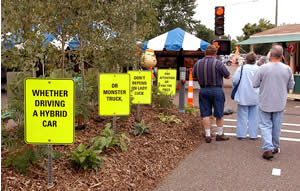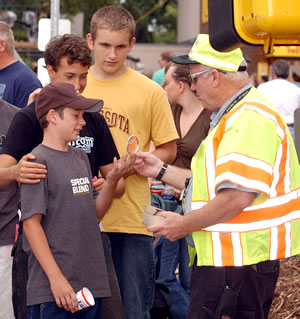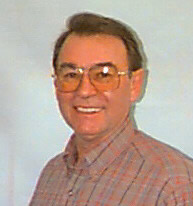 |
 |
|
 |
Work zone safety keeps high profile at Mn/DOT’s State Fair booth |
 |
 |
 |
|
Messages, such as those printed on signs at Mn/DOT's State Fair exhibit, reinforce the department's safety theme, "Work Zones: Pay Attention or Pay the Price." Photo by David Gonzalez
|
Whether driving a hybrid car
Or monster truck,
Don’t depend on Lady Luck.
Pay attention or pay the price.
So cautioned a series of road signs á la Burma-Shave (see article below) that lined the walkways at Mn/DOT’s exhibit at the 2004 Minnesota State Fair.
The signs, written by Craig Wilkins, Communications, were just some of the new additions to the department’s annual exhibit. The exhibit focused on transportation safety (both winter and summer) and updates to the state’s 5-1-1 traveler information system. Displays included information about safe travel in highway work zones and safety tips for walking, biking or driving along or across state roads or railroad tracks.
“The State Fair is a great way for Mn/DOT to put a human face on a public agency,” said Donna Lindberg, Communications, co-coordinator of the exhibit. “It gives us a chance to meet the public and educate them on important issues as well as listen to their concerns.”
 |
Mn/DOT's exhibit attracted visitors from as far away as France. Marsha (middle), a native Minnesotan who lives in Toulouse with her husband and daughter Stephanie, wanted to give her daughter the opportunity to experience the Minnesota State Fair "at least once." Pictured with them is Marsha's brother Brad, who lives in the Twin Cities. Photo by David Gonzalez |
Also new this year was the Freeway Incident Response Safety Team truck, one of eight bright yellow-green vehicles that cruise 150 miles of the Twin Cities metro area freeways helping stranded motorists and minimizing traffic delays and potential dangers caused by incidents.
As in years past, a 25-ton snowplow anchored the exhibit, attracting both kids and adults to examine its cab as well as the mounted crash attenuator at its rear. Work Zone Safety Charlie Brown, the five-foot-high statue, and larger-than-life painted cutouts also were available to give fair-goers photo opportunities.
When summer sun
Turns to winter snow,
Check 5-1-1, make
Sure it’s safe to go.
Check 511mn.org.
Nearly 100 Mn/DOT employees from the districts and Central Office worked six-hour shifts at the exhibit, answering questions ranging from when specific highway projects were expected to be completed (it depends) to what company manufactured the snowplow (Sterling) to where could they get free yardsticks (Public Safety booth). More than a few fair-goers were curious about how they, too, could work for Mn/DOT (check the department’s Web site at http://www.dot.state.mn.us/careers.html).
Lt. Gov./Commissioner Carol Molnau made several appearances at the fair in her dual official roles. Among other duties, she answered questions and distributed free highway maps at the Mn/DOT exhibit, appeared as a guest on many radio shows broadcast from the fair, emceed the Royal Canadian Mounties parade, presented awards to top county senior citizens and participated in and judged many agricultural contests.
Molnau, a life-long farmer, even won first place in a celebrity cow-milking contest.
 |
Jim Deans, in safety vest, Metro District, instructs visitors on the proper way to safely use crosswalks. Photo by David Gonzalez |
For additional photos and information, check out Mn/DOT’s fair Web site at www.dot.state.mn.us/fair.
And remember:
Keep your speed
Within the limit,
Don’t waste your cash
To save a minute.
Fines double in work zones.
Burma-Shave signs once promoted shaving cream, safe driving to nation’s motorists
The signs in Mn/DOT’s exhibit promoting work zone safety may look familiar to some visitors—they are modeled on the Burma-Shave signs that once sprouted along the country’s roadsides.
In 1925, Minneapolis businessman Clinton Odell started producing and marketing his shaving cream. He decided to use a series of six signs to convey his message about Burma-Shave.
The first signs appeared in Minnesota, Wisconsin and Iowa in 1926; they spread to rest of the country by the 1930s.
After using the rhyming signs to promote his product for several years, Odell began incorporating safe driving messages as well.
Hardly a driver
is now alive
who passed
on hills
at 75
Burma-Shave
The era of Burma-Shave signs ended in 1963. Although the signs are gone, they remain a part of the country’s cultural heritage. A set of the signs was donated to the Smithsonian Institute in Washington, D.C. in 1964.
By Craig Wilkins
|
|
back

|
 |
State responds to Minneapolis council’s vote on I-35W Crosstown Commons project
|
 |
 |
On Sept. 3, the Minneapolis City Council voted to deny municipal consent to the proposed I-35W/Crosstown Commons project and voted to request some 40 modifications to the project ranging from storm water treatment to state funding commitments for regional transit service.
Gov. Tim Pawlenty and Lt. Gov ./Commissioner Carol Molnau issued the following response to the vote:
“The council’s vote is contrary to the wishes and interests of the region, and will likely result in project delays, significant cost increases and unnecessary inconvenience for commuters who drive and use transit. It is hard to understand why the Minneapolis City Council is standing in the way of a project so strongly supported throughout the region, and one that would provide extensive benefits to commuters, current and future transit and the city itself.”
According to Bob McFarlin, assistant to the commissioner for transportation policy and public affairs, “The administration now must take some time to review and assess the extensive resolution passed by the council and determine a course of action.”
State law requires municipal approval for state highway projects within municipalities when they:
- Alter access
- Increase or reduce traffic capacity
- Require acquisition of permanent right of way
For additional information, follow these links:
By Kay Korsgaard
|
back

|
 |
Congestion overtaking American cities, says Texas research agency |
 |
 |
American cities, including the Twin Cities metro area, are losing ground to congestion, according to 20-year trend analysis announced yesterday by the Texas Transportation Institute, a research agency for the Texas Department of Transportation and the Texas Railroad Commission.
The 2004 Urban Mobility Report, published by TTI, shows traffic congestion growing across the nation in cities of all sizes.
The report compares Minneapolis-St. Paul to similar urban areas such as Atlanta, Orlando, Seattle and Phoenix. According to Metro planning director Tim Henkel, the overall trend shows that the Twin Cities are above average in total delays and total costs of congestion.
David Schrank and Tim Lomax, authors of the report, say Twin Cities commuters each lost an average of 42 hours to rush-hour delays in 2002. The authors credit ramp meters and other traffic-management systems for keeping the total below 50 hours.
“The consensus is that we have more people making more trips than ever in the Twin Cities metro area and delays caused by traffic congestion are lengthening,” said Henkel. “We are nearing our limits on where those systems can slow traffic growth.”
Henkel said commuters will see some relief, thanks to recent project completions and projects funded by the 2000 and 2003 legislatures, but that congestion will continue to be troubling.
“Congestion will ease in some areas as major projects are complete, but these will be in spot locations like the Wakota Bridge south of St. Paul, Hwy 100 west of Minneapolis, I-94/I-694 in the northwest suburbs and when we ‘unweave the weave’ at I-35E and I-694,” he said. “We still need to look for new ways to add highway capacity and transit options across the Metro.”
The TTI study ranks areas according to several measurements, including annual delays spent in traffic, annual financial cost of traffic congestion and wasted fuel lost to engines idling in traffic jams. This year’s installment increases the number of urban areas studied from 75 to 85, and includes all urban areas exceeding a population of 500,000.
A complete copy of the study is available at http://mobility.tamu.edu/ums/. Click here to view how Minnesota fared in previous TTI mobility studies:
By Jeanne Aamodt
|
back

|
 |
Carol Zoff receives national honor for Great River Road support |
 |
 |
 |
|
Carol Zoff, landscape architect with Technical Support. Photo by David Gonzalez |
Efforts by Carol Zoff, a landscape architect with Technical Support, to support development of the Great River Road earned her the Mississippi River Parkway Commission’s Distinguished Service Award.
The 10-state body’s mission includes promoting and enhancing the resources of the Mississippi River Valley and developing the highways and related amenities of the Great River Road.
Zoff serves as Mn/DOT’s Great River Road program manager, chairs the commission’s National Transportation Committee and recently co-authored the “Great River Road Interpretive Plan and Tool Kit.”
Mn/DOT is one of five Minnesota state agencies that support the work of the Great River Road, one of 95 nationally designated scenic byways. Minnesota has six scenic byways that have received national designation.
Zoff said the parkway commission is developing a curriculum in context-sensitive design that focuses on the Great River Road to meet the needs of the member states’ transportation departments.
“The curriculum will describe the natural, aesthetic and historic resources essential to the river experience, as well a list of resource contacts, design examples, CSD principles and a summary of cost-sharing policies,” Zoff said.
“We hope that road development and management can become more effective and the travel experience enhanced,” she said. “The curriculum will provide a common vision and language for transportation officials, river and community leaders as well as for parkway commissioners.”
By Craig Wilkins
|
back

|
 |
Cancer claims life of District 7’s Larry Filter |
 |
 |
 |
|
Long-time Mn/DOT employee Larry Filter, Mankato/District 7 preliminary design engineer, died of cancer Sept. 5. |
Funeral services were held today, Sept. 8, for Larry Filter, preliminary design engineer at Mankato/District 7, who died Sept. 5 of cancer. He was 63.
Filter began his 40-year career with Mn/DOT following his graduation from the University of Wisconsin-Platteville in 1964 with a degree in civil engineering.
He was respected by his fellow employees for his knowledge, professionalism and caring ways, said Rebecca Arndt, district public affairs coordinator. Filter was recently honored for his 40 years of service with Mn/DOT.
Filter was known in the community for his wide-ranging interests including photography, genealogy, travel and bird-watching. He also served as a leader in his church and with a Mankato area square dancing club.
Survivors include his spouse, four children, two siblings and three grandchildren.
|
back

|
 |
|
 |



